JBL Bar 2.0 All-in-One Reviewed at $150.00
Product Name: JBL Bar 2.0 All-in-One
Product Description: 2.0 CH Soundbar
-
Design - 9/10
9/10
-
Movies Performance - 8.3/10
8.3/10
-
Music Performance - 8.5/10
8.5/10
-
Inputs and Features - 8.4/10
8.4/10
-
Price / Quality - 9/10
9/10
Summary
Reviewed at $150.00
Pros
- Nice design
- Can get loud for its size
- Very easy to setup and use
- Low price
Cons
- No DTS support
- No EQ settings
- No surround activity
- Bass is average
Cheapest Places to Buy :
*We are a reader-supported website. When you buy through links on our site, we may earn a small affiliate commission at no extra cost to you. Home Media Entertainment does not accept money for reviews.*
There is certain appeal when it comes to these low cost, easy to use soundbars. Yes, they are not the performance behemoths that some bigger and more expensive units claim to be or they will not offer you a night and day difference compared to what your TV can do but they have certain strengths that many people like and choose them for, and this is no other than the fact that for such a low cost you get an upgrade on your TVs sound performance all the while keep things very simple in terms of everyday use as well as setting everything up. And in our JBL Bar 2.0 All-in-One review we will be looking at such a model from our known JBL.

JBL has refreshed their entire lineup and the new releases have many things in common between them as they use similar designs and features that naturally scale according to the price. This new unit is supposed to replace JBL’s Bar Studio soundbar and is placed as the new budget friendly, single unit soundbar that is positioned right below their JBL Bar 2.1 Deep Bass unit that we had reviewed recently. Indeed in terms of features the Bar 2.1 Deep Bass and the Bar 2.0 All-on-One have many similarities and features and we will try to pinpoint their differences whenever we see them.
But just to keep things in perspective the JBL Bar 2.0 All-in-One that we will be looking here today is a single unit soundbar consisting of a 2.0 channels audio system, supports Dolby Digital and comes with the standard set of features that we see in these low cost units including Bluetooth and USB streaming, HDMI connection, some very basic audio settings and a very easy and plug-and-play design.
Competition is really fierce in this category and there are many players that are trying to get a piece of this market. And with most soundbars coming with more or less the same features what makes or breaks such a unit is its ability to offer a noteworthy update in the sound output compared to what your TV can do. Does the new JBL Bar 2.0 All-in-One manages to stay ahead of the competition, or it is lost in a sea of equally good performing releases? Let’s find out.
Design, Inputs and Features
Exterior
The Bar 2.0 All-in-One follows the new design lines that most new JBL releases have. It looks simple with straight lines and very subtle curves and will certainly go unnoticed in most situations.
The unit certainly feels like a shrank version of the Bar 2.1 Deep Bass and measures just 24.17” x 2.28” x 3.54” (614 x 58 x 90 mm) and with a weight of just 3.50 lb (1.61 kg) making it not only easy to handle but can also fit under any TV size including the smaller ones measuring under 40″ which makes it an excellent choice if you want to place it under a gaming monitor or something similar. And if you take into account that it uses only front firing drivers while there is no subwoofer you should have no trouble placing it under your TV or anywhere in a small furniture no matter its size and design.
In terms of actual looks JBL has been using similar materials in many of their offerings and this ones is no different as it uses a dark gray plastic that covers most of the top, bottom and back sides. The perforated grille that covers the entire front side hiding the drivers and front display extend to the sides even though there are no side-firing drivers available. The entire design was made in such a way in order to go as much unnoticed as possible and for sure many will appreciate that. It’s both effective and simple and surely gets the job done.
The top side is very minimal as the only thing you will find is the built-in controls that have been positioned dead center in a specially designed groove made out of some short of rubber silicone which is a nice practical addition in case you will be looking for them in a low lit room. In front of the control buttons there is the JBL logo sitting prominently breaking the otherwise monotonous top face.
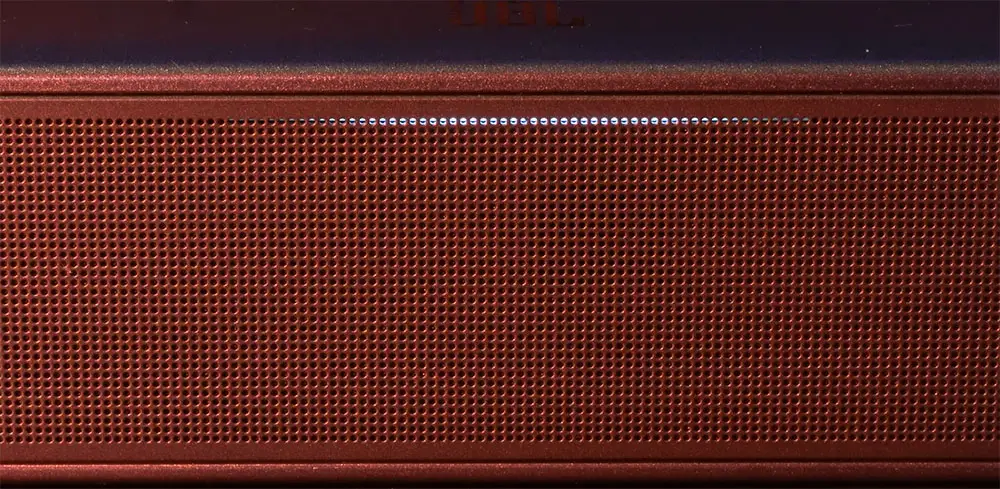
When it comes to front displays it’s a hit or miss situation really as many soundbars fail to utilize a fully functional display and instead use LED indicators to shows what the soundbar is doing. And this is what we have here. At the center of the unit, under the perforated grille there is a LED indicator that changes colors depending on the function. As for the volume, as you change it the indicator has a stretching effect which is slightly better and gives you some visual clue of the level you are now.
The back of the unit is where all the connection ports are located in a centered inset specially designed to help with the cable connectors. There are also some holes for the included wall mounting brackets along with a big air port on the right side that has been included to help with better bass extension. With the lack of a dedicated subwoofer the inclusion of such an air port will come handy when it comes to low end action. But more on this on our test section.
Overall the JBL Bar 2.0 All-in-One follows the same design and quality standards that all the new JBL soundbars have. Its design lines are simple but good looking with nice subtle curves while the materials used are what you would expect from such a low cost offering. Nothing bad to say really but nothing that will blow your mind either.
Internal Hardware
The unit is the typical 2.0 channels soundbar that includes the two main channels in the main bar and nothing else. JBL has rated the soundbar at 80 watts of power (Max. @THD 1%) with 2 x 40 watts for the main unit which is actually an upgrade if you consider that the JBL Bar Studio had 2 x 30 watts power output.
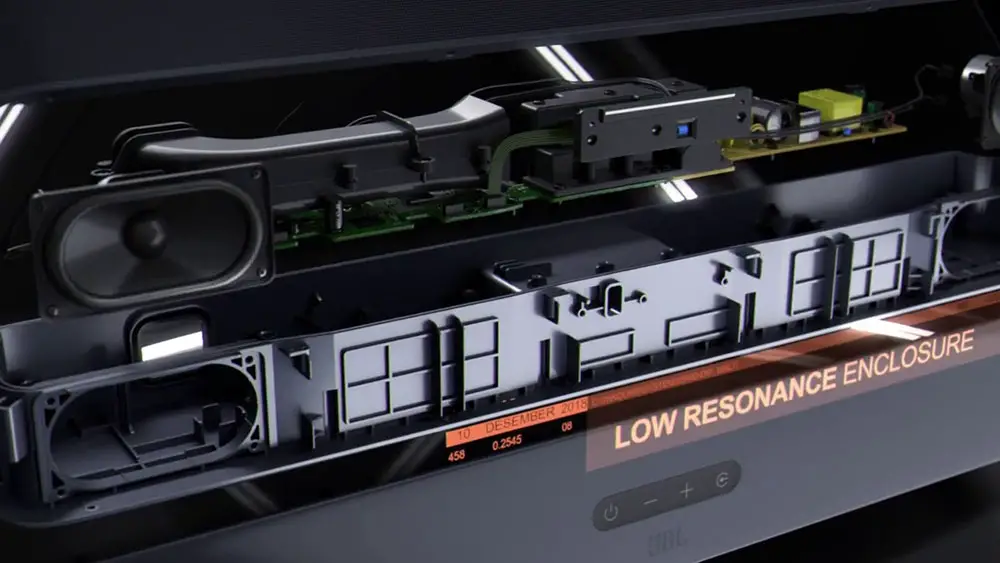
Each main channel consists of a single high excursion racetrack driver which is the most simple audio setup you can get. Racetrack drivers are very commonly used in low profile soundbars as they provide similar output and sound quality without compromising their size and footprint.
The soundbar drivers give the Bar 2.0 All-in-One a frequency response of 70Hz ~ 20kHz which is just about what you should expect from such a small size.
Connectivity
Let’s see now what kind of connectivity options JBL has included in this one. As we already mentioned all ports are located in a special inset at the center of the back side. What we like a lot is that unlike other manufacturers JBL is placing their power connector close to the other ports and thus makes grouping of all cables much easier.
Now with the Bar 2.0 All-in-One being such a low cost unit, this was bound to reflect on the available ports. What we get is an optical input, a USB port and a HDMI output…that’s all.
The first thing that we immediately noticed is that while the Bar Studio also had an analog audio mini-jack this time it was missing completely. We have said before that many manufacturers are slowly phasing out their analog ports and we have seen this across the whole home theater market from TVs, amplifiers and now soundbars.
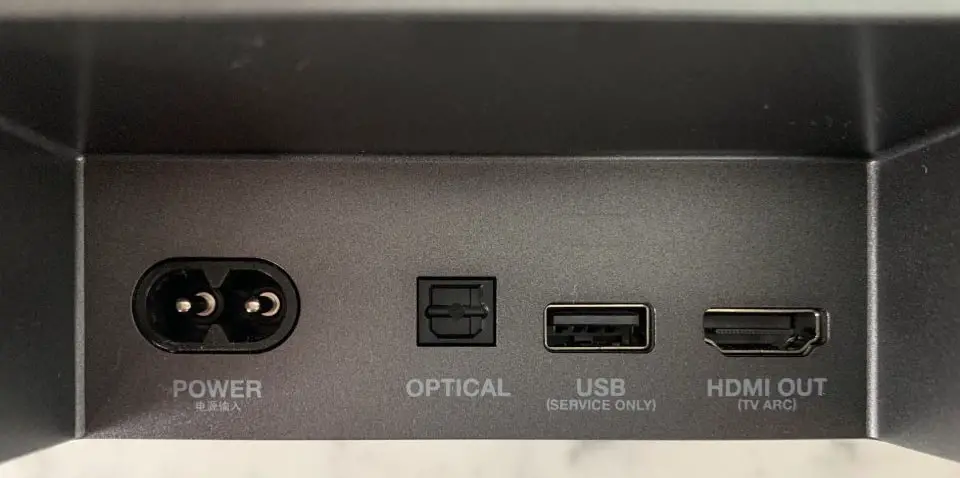
Another thing to point out is that we only get an HDMI output and no input as per usual. The included port at least supports ARC functionality so it can be used as a means to transfer audio from the TV to the unit. But because of this the soundbar cannot be used as a middle man in the chain as it lacks the means to transfer the video signal which is a shame really as we have seen many dirty cheap soundbars at least including one input and one output.
In terms of wireless capabilities the soundbar comes only with Bluetooth v4.2. No WiFi is available here.
Overall we are a bit disappointed here. The omission of the analog port is not a big one but having a single HDMI port, meaning no signal pass-through really stinks. When there are so many soundbars in the same price range with both inputs and outputs the Bar 2.0 All-in-One feels slightly behind competition.
Control Options
Let’s see next the means of controlling this soundbar. As always first comes the included remote and the one we get is extremely similar to the one we had seen in the Bar 2.1 Deep Bass only two buttons minus.
To be honest this must be one of the most simple remotes we have seen in any soundbar and will certainly not wow anyone with its design and looks. Its plastic quality is good but nothing out of the ordinary and it is slightly longer than what you would expect from a remote that has a total of five buttons to handle.

At the top center we find the power button while below there are two buttons for TV source selection and Bluetooth functionality. Below these we get a larger volume control button while at the middle of the remote below everything else we get the mute function. And that’s all!
To be honest the soundbar’s list of features is very limited so what the remote has is pretty much enough for everything you need. The remote lacks any kind of backlight functionality obviously, but at least the circular buttons have enough distance between them to avoid accidental commands.
The built-in buttons layout is once again as simple as it gets. The first button from the left is for power followed but two buttons for volume control. If pressed together they act as mute control also while on the far right we get the source selection button which switches between TV and Bluetooth.
The soundbar also supports HDMI-CEC so in case you have a TV for example that also supports this feature you can use that remote and control both devices. This way you can use less remotes in your viewing area. But the soundbar also has the ability to be controlled by another remote even if HDMI-CEC is not supported. This is done by the TV remote control learning functionality and with it you can use any remote from any device and make the soundbar learn what specific signals should correspond to specific actions. The manual has very easy to follow steps in doing that.
The unit lacks any kind of mobile app or voice control support that some of the higher tier JBL soundbars offer so the remote is your main and only means of controlling the unit.

Extra Features and Services
The unit focuses on being as simple as possible and in order to keep its low cost and everyday use simplicity extra features are not exactly in abundance here. In fact we get even less features than what we had seen in the Bar 2.1 Deep Bass which was already a pretty much stripped down model in terms of features.
First of all lets talk about the audio support. JBL has always been very secretive of what kind of audio formats their soundbars support. For the JBL Bar 2.0 All-in-One we get the mention of Dolby Audio support which basically means Dolby Digital which is being downmixed into 2.0 channels in order to playback by the unit. Obviously Dolby Digital is enough in most cases but we are disappointed not to see DTS also. This should be a standard nowadays. Many JBL units don’t support DTS so we are not so much surprised by this to be honest.
In terms of audio settings things couldn’t be more simple. There is only one setting available that you can fiddle with really which is called Audio Sync. There is nothing else, it’s that simple. The Bar 2.1 Deep Bass had an additional setting for bass which is missing here but if you consider that we don’t have a dedicated subwoofer this time it’s not that much surprising.
As far as actual sound modes we get two which is the usual for JBL. There is the Smart Audio mode which is enabled by default, and with it you can enjoy TV programs with rich sound effects. For TV programs such as news and weather forecasts, you can reduce sound effects by disabling the Smart Audio mode and switch to the standard mode. With the Smart mode the EQ settings and JBL Surround Sound are applied for rich sound effects while with Standard mode the preset EQ settings are applied for standard sound effects.
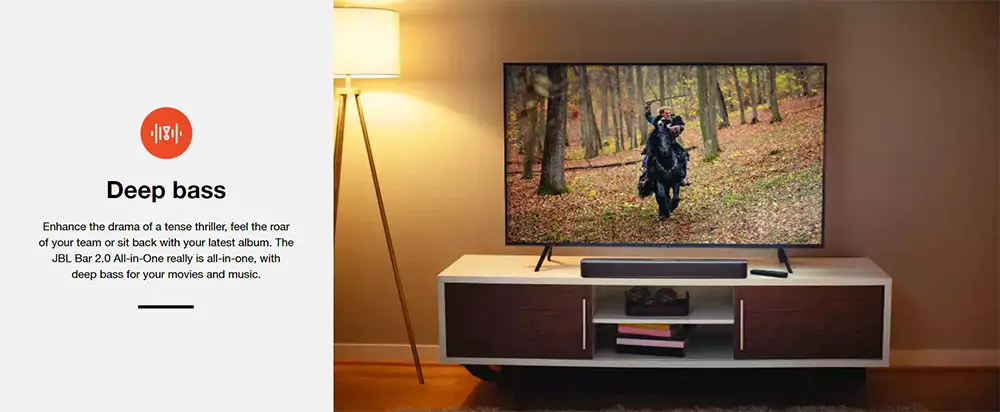
The soundbar doesn’t feature any kind of auto sound calibration system but this shouldn’t be a problem as the amount of sound settings available are so few that you don’t have to spend time making any calibrations manually. So there was no need really to include one.
The soundbar also offers some basic streaming capabilities as with the included Bluetooth function you can stream audio from any mobile device. Now there is also USB streaming capabilities but, as we already mentioned above, for some reason this has only been included in the US models. Keep in mind that this function is extremely limited as only MP3 and WAV files are being supported this way. Many of their latest models feature USB playback only in the US market but not anywhere else so we cannot be sure why this design decision was made but seems to be universal across their entire lineup.
As the unit lacks WiFi functionality this means that there are no features related to online streaming. So if you are interested in Chromecast or Airplay you will be disappointed as this unit only supports local streaming through its Bluetooth. For online streaming you will have to look at the more expensive JBL Bar 5.1 Surround.
When we reviewed the JBL Bar 2.1 Deep Bass we were surprised how light the unit was in extra features and it seems that the Bar 2.0 All-in-One take this one step further as it comes with even less features with the omission of the bass settings we saw in our previous review. If you want a soundbar that has the absolute basics and you are totally bored of having to fiddle with any sound settings you will surely fall in love with this one.

Initial Setup
If simplicity is your number one decision factor then the All-in-One soundbar is the one you will definitely fall in love with. With the limited connections available we opted to connect our 4K UHD player to our test TV itself and then use the HDMI ARC connection to pass the audio to the soundbar. That’s all the connections you need to make.
Now as the default mode every time you power it up is the Smart Audio mode with JBL Surround sound you practically don’t have to do anything as everything is set for you. No auto calibration systems, no complex settings and audio features, no EQ management that could take you more than a few minutes to be ready. You can obviously use the standard audio mode but we chose to use the default one.
Obviously being so simple to setup and use is not for everyone. If you want to have some management over your audio there are other options to consider but if you just want the perfect plug-and-play soundbar the JBL Bar 2.0 All-in-One is so simple even a child can handle it.
Movies
For this review we tested the 4K UHD version of Mad Max: Fury Road. Now we could talk hours about how spectacular its Dolby Atmos mix is but unfortunately the soundbar doesn’t support Atmos so we have to settle for the core Dolby Digital track that is down-mixed into 2.0 channels that can be played by the Bar 2.0 All-in-One.
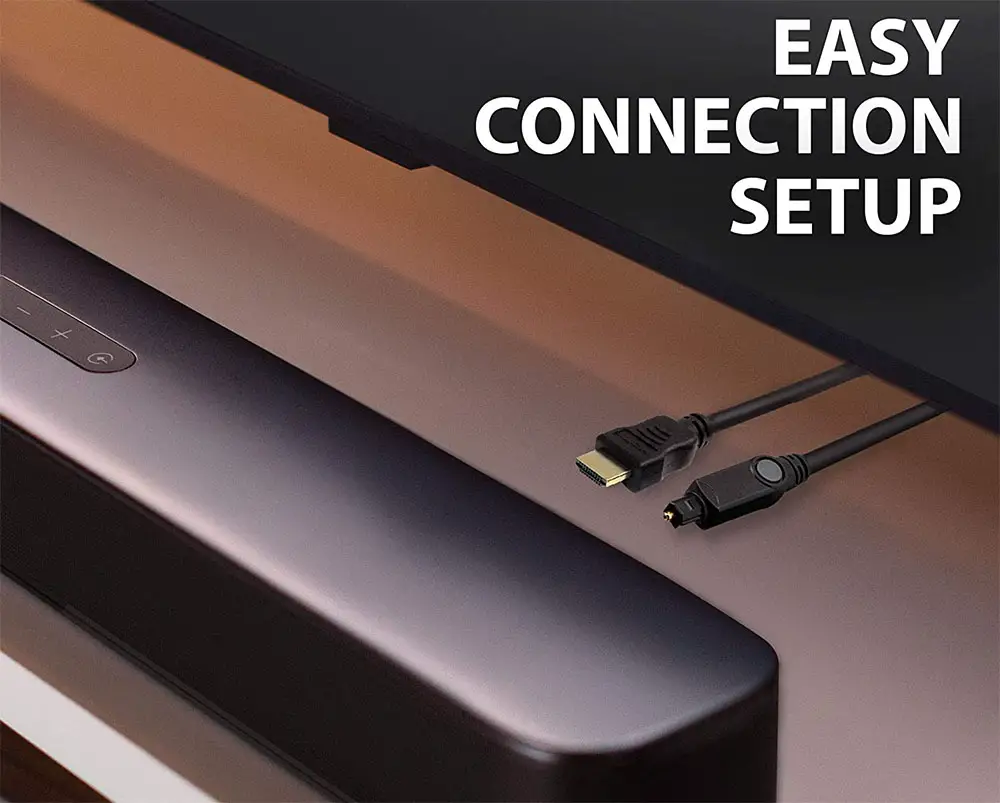
We did a comparison between our TV and the soundbar itself because we wanted to see how much difference we would get going from the TV speakers to the JBL one and to be honest the difference was there. It was not the kind of upgrade that blew our minds but going from two tiny down-firing speakers to two bigger forward-firing racetrack drivers gave us improvements across the board.
Suddenly the front soundstage felt wider and deeper than before. When you first look at the size of the unit you don’t expect that it can stretch the sound so much as it did so this really was a good surprise. Audio quality and resolution was good enough, all things considered, but don’t expect HiFi material out of this one. Also the dialogue was very distinct even though there is no dedicated center channel. The soundbar did a good job to separate the dialogue from the rest of the sound elements and in most cases it did it with satisfying results.
JBL do advertise the soundbar of having their proprietary JBL Surround Sound technology but to be honest all this did was to just make the sound feel slightly closer to our position and give you a sense of greater volume with slightly more sideways extension. There was no real activity or over-the-shoulder action and everything was firmly coming from the front which was what we expected really. There is no magic that can create real surround sound without actual rear speakers unfortunately.
The soundbar is lacking a dedicated subwoofer so in terms of low end action the unit failed to give the content the necessary weight. Explosions, engines roaring and metal bursting into flames felt more flat and less realistic due to this. It is not all doom and gloom though. The soundbar do try to dig deep and sometimes it did manage to push the lows in a more satisfying way while it seemed that the rear air port did help in certain moments. But when there was too much action on the lower frequencies it felt like the soundbar just couldn’t keep up the pace.

For a change we went with Alita: Battle Angel in 4K UHD that also uses a very satisfying Dolby Atmos track. Again we got the core Dolby Digital track that is downmixed in 2.0 channels for the soundbar to output. What we heard in this test was very much in line with what the soundbar did in the Mad Max movie.
Essentially you will get a nice boost at the front with good details, nice extension, good separation of the center channel with very discrete dialogue but very little in terms of surround activity and rear action. Even during busy scenes we never felt like we could not hear what the actors were saying so all good in this respect.
The Motoball action sequence is obviously the highlight of the film and here the soundbar did a good job with certain panning effects considering the limitations of the hardware. There were certain moments that you could feel the sound moving from one channel to the other and certainly added to the wow factor.
The bass once again was average, there were certain moments were the soundbar provided good bass for what was on screen but when the moment asked for deeper notes it was when the JBL failed to provide the necessary output that could really elevate the moment.
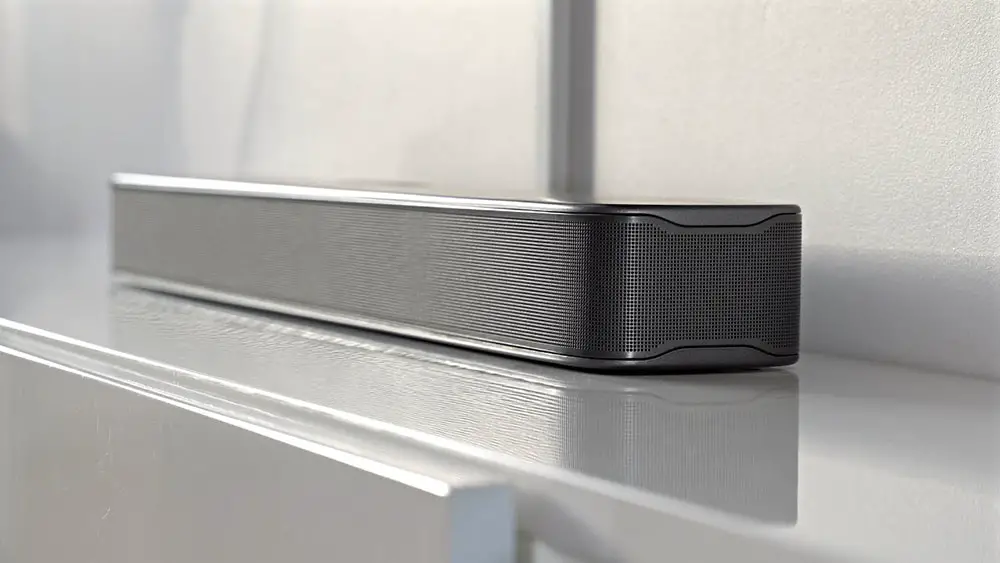
Overall the soundbar has plenty to give and although using it under a gaming monitor or in your bedroom will give you a bigger impact, using it as your main audio system in your living room will still provide you with nice boost in performance compared to your TV speakers and in the end this is all that matters.
Music
Next we have our music tests and for this one we streamed some WAV files through the USB port as the unit we were testing was meant for the US market. Keep in mind for other markets there is no USB playback and you have to settle only with Bluetooth streaming which has obviously less quality.
The soundbar is obviously extremely limited by the hardware used so you shouldn’t expect anything fancy out of it. It will give you good output in terms of audio rendering, clarity and precision but it will never amaze you with its sound. It feels like it can nicely fit into the casual music category where most users just want to hear some every day music without caring much about the details.
The mid-range was ok without the soundbar missing certain points too much while the high frequencies had good energy and vibrancy. There were a few moments that the vocals sounded a bit more harsh, something we had also noted on the JBL Bar 2.1 Deep Bass but it was not always happening and it came down to the kind of vocals each song had.

Once again a missing subwoofer remind us how much more satisfying an experience one can provide and how much lower it can go in the frequency spectrum. And keep in mind that the unit is missing any bass settings so you cannot actually change anything. What you hear is what you get. In certain moments where the song was more demanding on the low end the end result felt soulless and uninspiring.
One area where the unit did very good was with sound imaging as it was able to render a nice soundstage in front of us with good precision and enough distinction between the sound sources in space. We have heard much better in this regard but for this price and this size it was satisfactory to say the least.
As always we put the soundbar through various types of music because we wanted to see if we would get the same kind of behavior across the board and it seemed that certain genres faired slightly better than others. Classical music that didn’t have many low end dips sounded very nice and showed that the soundbar can be more delicate if the source material allows it. But with some genres that demand bass prowess the soundbar just can’t follow through and this leaves a sour taste in the mouth.
In total if you are a casual music listener then the soundbar will provide you with many hours of acoustic enjoyment. Just be sure to know what you are getting and don’t have great expectations out of such a low cost release. If you know what to expect then it can certainly please you with the results.
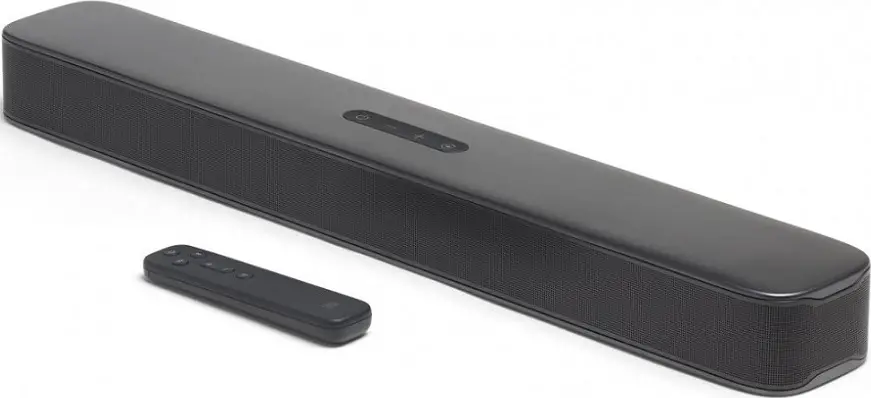
Final Thoughts
JBL certainly knows how to create easy to use soundbars for those that just want one that connects and plays immediately without much trouble. And while the JBL Bar 2.0 All-in-One is not the kind of material that will shock you with its performance it certainly knows its limitations and its target audience.
The strength of this unit certainly is on its simplicity. Easy to handle, easy to place and easy to connect is what this is all about. It is the epitome of a plug-and-play device and you will literally start using it from unboxing in just a few minutes. Build quality is good enough but don’t expect anything fancy at this price while the bar can certainly go loud and improve the sound quality of your TV despite its compact size.
On the downsides we didn’t like the fact that JBL continues not to support DTS even though there are many other low cost offerings that do so. Also the amount of sound settings available is almost non existent while surround action was missing in action as all sounds were firmly positioned at the front. Lastly having no subwoofer really hurt its performance on the low end and although JBL added a rear air port in order to help a little with the lower registers it still felt a bit flat and uninspiring.
Closing our review what we can say about the JBL Bar 2.0 All-in-One is that it can be an excellent choice in certain cases. That would be to improve the audio of an old TV, to complement your bedroom TV or add it under your gaming monitor. It could still provide a nice experience as your main audio system in your living room but keep in mind that its limited capabilities will not provide you with a day an night difference from what your TV can. The difference is there but it will be much more subtle compared to the other cases we mentioned.
With all these in mind this one definitely deserves a chance if you are looking a compact and extremely low cost unit but with certain quality standards that stem from the JBL brand.
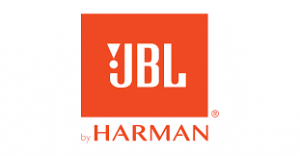
For more reviews you can check our dedicated Single Soundbar reviews list or even look at our Product Reviews Table where you can find the brand and specific product you are looking for.
Cheapest Places to Buy :
*We are a reader-supported website. When you buy through links on our site, we may earn a small affiliate commission at no extra cost to you. Home Media Entertainment does not accept money for reviews.*
To me, JBL certainly has superior sound when compared to other soundbars I had tested, but they are also slightly more expensive where I live. But what I like the most is the easiness of use. I am not very much into tech gear so making this as simple as possible is a necessity.
Hello Michel. If you look for simplicity then it cannot get any better than this one. Trust me on this.
I am considering a soundbar but I am thinking if it is enough. What I want is to be able to clearly hear the words in my favorite TV programs without having to strain my ears, so do you think this one will suffice? I don’t need anything expensive to be honest.
It’s not easy to answer that because I hear differently from you. For me dialogue was pretty distinct and clear enough but only your ears can determine if it is good enough for you. If you cannot test it then I have to say that it’s enough but there is always the risk that of not getting what you want. In that case I always suggest that you buy from somewhere that you can return it if it is not satisfying enough for you.
First of all thanks for this detailed review, I like it. At the moment I’m looking for some single speaker soundbar to replace my Sony HT-XT1. I like how the device sounds but I would like to replace it since it is overkill with the glass top and buttons too much in the front so my kids change audio source too frequently. We use the TV only to play kids stuff so no true HiFi is really required there but our 2019 Sony TV sounds so badly soundbar is really must. Finally I would appreciate if you could add some alternative device at the end of your review (or at least in the comments) so I can compare and consider between two. Thanks.
Hello Viktor and thank you for your comment. I can give you a few suggestion but in order to do so I need you to tell me if you have some budget limitation. You already mentioned you want a single unit soundbar but prices are all over the place. If you can give me a number at least I will know where to focus more and give you some suggestions. Cheers!
Hi Stratos, since I’m considering this JBL device my budget is +/- the same. I would like to avoid any Chinese brand like Xiaomi or TLC. I expect it should be available on the European market. Thanks.
Hey Viktor. In that case I would consider this to be your only option. For a soundbar of similar size, being a single unit and also at this price at least from the ones I know there is no other. There are a couple of options with similar single unit design and similar size but their price is higher than the JBL.
Great review!
I would have liked to see thoughts though of how it compares to the JBL Bar 2.1 Deep Bass, and if the Deep Bass is worth springing some extra cash on compared to this, as they are somewhat similar products.
Hello Mark. If you are watching movies then spending a bit more for the JBL Bar 2.1 Deep Bass is recommended. More power output and deeper bass is what you will get. The Deep Bass is a clear improvement over the All-in-one as the dedicated subwoofer helps a lot.
Hello,
Is it possible to later add a JBL wireless subwoofer (Say a 10 inch) to improve performance?
Hello Joseph. Unfortunately the JBL Bar 2.0 All-in-One cannot accept a subwoofer. What you see is what you get.
Hi, I am looking for a small soundbar to beef up the sound from my 50inch tv. Is there much difference between this and the Bose TV speaker. This is half the price of the Bose where I live , would you say this is on par sound quality or is the Bose signficantly better ?
In terms of audio quality the difference is not big. But I prefer the Bose because it supports both Dolby Audio and DTS while the JBL supports only Dolby and with the Bose you can add a subwoofer if you feel that the main unit is lacking on the bass. But if price is of concern to you and you do not care for DTS then you are not going to be missing much with the JBL in terms of pure front stage performance.